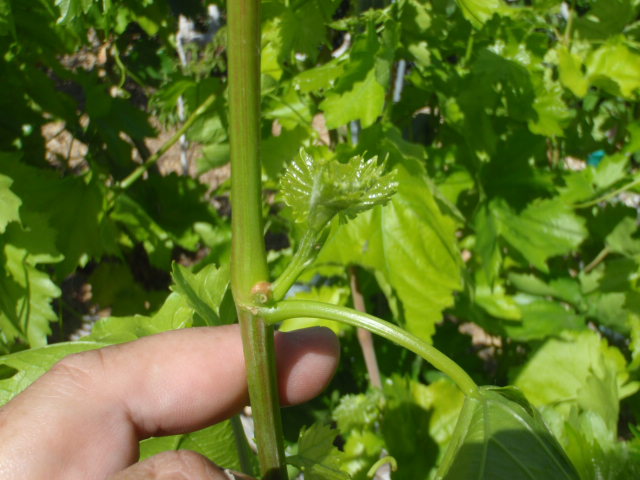Q. I read
your column about fruit and flowers only growing on 2 year old wood
grapevines. So now I am confused about
how to prune my beautiful grape vines. Just what do I remove, or do I even need
to remove any of the vines?
A. Yes, it
can be confusing. Maybe you can think of grapes this way. The first year the
plant pushes new growth. There is no fruit on first year growth (first year
wood). This new growth must be fully grown and mature to support the fruit that
will grow on it the following year (second year wood).
 |
| This is new growth of grape, a few months old. This growth will produce fruit the next year, second year wood. |
The second year the plant again pushes new
growth from its end or sides (first year growth). First year growth always
comes from second year wood. While it is pushing this new growth, it is also
pushing flowers and fruit to grow on the previous year's growth (second year
wood). The vine is doing two things at the same time. It is always pushing new
growth that does not support fruit (first year wood). At the same time it is
pushing flowers and fruit from the previous year's growth (second year growth).
 |
| This is a grape flower cluster that will become a bunch of grapes in about five months. These grape flower clusters can only grow from stems or wood, that are growing in their second year. |
Different grapes produce flowers and fruit in
different locations along second year of growth. Some grapes produce flowers
and fruit at the very base or bottom of the second year growth (second year
wood). This fruit is mostly produced very close to the juncture of the first
and second year growth. When pruning these kinds of grapes we only have to leave
about 1/2 inch of the second year growth remaining. The rest is cut off.
Removing all of the second year growth except for one half inch results in a
"spur" of second year wood. We say that these kinds of grapes should
be "spur pruned". From these "spurs" we allow new growth
but this new growth is always cut back again leaving only about 1/2 inch. From
these "spurs", it is a continuous cycle of growth one year and
cutting it back to 1/2 inch in late winter of the second year. Growth and cut
back to a half inch, growth and cut back to a half inch, etc.
Other grapes do not produce flowers and fruit
at the base of the second year wood. Instead, they produce flowers and fruit
further away from the base at a distance of perhaps 10 or 12 inches from the
base or more. When we prune these grapes, we must not cut back too much or we
will remove all the fruit. When pruning grapes such as these we must leave very
long spurs to accommodate for the flowers and fruit. We no longer call these
"spurs" because they are too long. Extra long spurs are called
"canes". Grapes that are pruned so that second year wood is 10, 12 or
perhaps 18 inches long are "cane pruned".
When pruning grapes it is important to know
where the fruit is produced along the second year wood. If the fruit is
produced at the base of second year growth, it is "spur pruned". If
the fruit is produced several inches away from the base, it must be "cane
pruned".



Thanks for that information! Are there any resources where I can find out if my particular variety is a spur-pruned or cane-pruned vine?
ReplyDeleteThere are two ways to figure it out. The first is to spur prune it one year. If you have no grapes then it should be cane pruned. The second is to cane prune it look at where grapes are produced. If some of the grape bunches are produced very close to the beginning of new growth then it can be spur pruned. The majority are spur pruned. Two that are traditionally cane pruned are Thompson Seedless and Black Monukka.
Delete